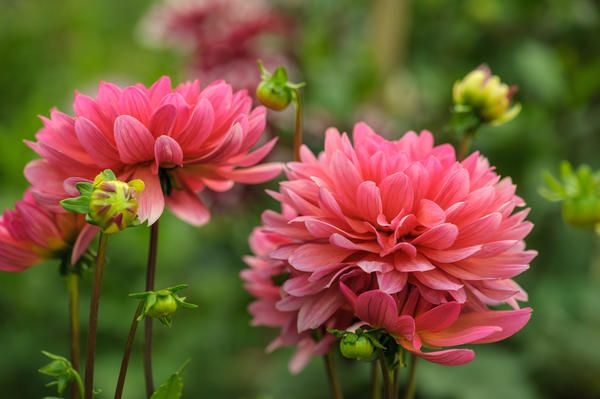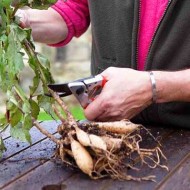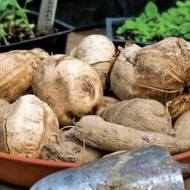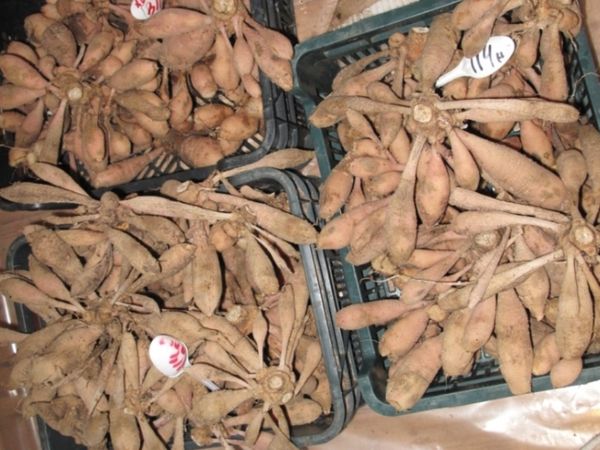How to prepare dahlias for winter with a minimum of financial investments
Content
Caring for the cold
Dahlias are flowers of the Astrov family. They bring up many of them to memories of childhood, the first call at school, their favorite teacher. These plants are very popular with flower growers. Their main features are a long flowering period and relative unpretentiousness. Flowers can adapt to almost any environment. As for lighting, the flower feels great both in sunny areas and in solid shade.
Autumn is the time to prepare dahlias for winter. It is this period that is decisive in the further fate of flowers, because proper autumn care is the key to a successful wintering and rapid spring development.
Dahlia care in the fall includes digging the tubers and storing them. To determine the timing of the digging, you need to focus on the condition of the flower. Dry stems and brownish tinge indicate that this is exactly the time. In the Moscow region and the middle lane, this period falls on November. In northern latitudes - at the end of October.
Video "Preparing dahlias for winter"
In this video, you will learn how to prepare dahlias for the winter period.
Preparatory stage
Before digging out the tubers, the bush must be prepared.With the onset of the first frost, they begin to clean the soil near the dahlias. All weak, old and injured stems are removed from the soil. It is also necessary to remove the stems affected by the fungal disease, as they can provoke the spread of pests to healthy flowers. Diseased stems are dug up together with an earthen clod and burned. In about five days, watering of the plant completely stops. Digging is carried out after the onset of severe frosts.
Digging
This process is relatively simple, but it includes several important stages, in which the sequence of execution is fundamentally important.
For beginner gardeners, there is a step-by-step "recipe" for digging tubers:
- The ground around the bush is dug in - this allows access to the roots of the dahlias.
- Using a shovel, they gently pry the bush, and holding it by the stalks, remove it from the soil.
- The roots are carefully examined for rot and damage. The diseased roots are separated and discarded. Very long roots are slightly shortened. This procedure will make the tubers compact, making them easier to store.
Dividing tubers
Much depends on how to prepare the dahlia tubers for storage in winter: both the activity of the growth of the shrub in the spring, and the splendor of flowering, and the general condition of the stems. That is why it is highly discouraged to neglect sorting tubers. This procedure involves cutting the rhizome into several parts, which will subsequently be planted. Sorting is carried out in the fall, since in the spring the roots become rather coarse and it is problematic to separate them. First, they are engaged in small and thin roots. They cannot be divided, therefore they are kept in whole groups.
A piece of the neck must be left at each delenka, otherwise the root may not sprout in the future. The resulting roots are washed well under running water and re-inspected to ensure that there is no damage or rot. As a disinfection, the roots are soaked in a manganese solution, after which they are well dried. Large tubers are cut a little in length. If the color of the cut is brownish, with rust, it means that decay processes have begun there. Such a tuber is pruned until the cut is clean. If, as a result of shortening, most of the tuber is lost, it is thrown away.
Labeling and storage
Marking plays an important role in autumn care. The main task of the gardener marking the tubers is to indicate as much information as possible for the further identification of the dahlia variety. Particularly strong roots are also noted. After all, later they can be grafted.
The main aspect of storing dahlia tubers is temperature. The thermometer mark in the room where the roots hibernate should not fall below 1 ° C, the humidity indicator should also be stable - 75–85%. If these norms are not observed, the roots can either freeze over or rot.
The main storage methods for dahlias include:
- Garden soil. The tubers are placed in a box and sprinkled with a small layer of wet sand, peat or soil. The layer thickness should not exceed 10 cm. This can be called wintering in its natural habitat. In addition, thanks to the thin layer of cover, the roots receive a sufficient amount of oxygen.
- Moss, sand. Tubers placed in a container are covered with sphagnum or sand. Good ventilation is important.
- Vermiculite. It is a material that resembles porous pebbles. The roots are stored in plastic containers filled with vermiculite. The downside is the ability of the material to produce moisture, which can provoke plant decay processes.
- Refrigerators compartment. In the absence of a cellar, some growers store tubers in the refrigerator. They are placed in a bag filled with sawdust and placed in the vegetable compartment. Several holes must be made in the bag for oxygen access.
An alternative approach
There is a rather unusual way of storing dahlia tubers. It consists in using paraffin as a protective material. The roots are prepared in the usual way, dry well and dipped in melted paraffin. After it hardens, the roots are wrapped in paper and sent to the box.
With a properly organized wintering, the tubers sprout rather quickly in the spring.
In addition, the shrub grows resistant to various kinds of pests and environmental factors. And this is a guarantee of lush and colorful flowering.





